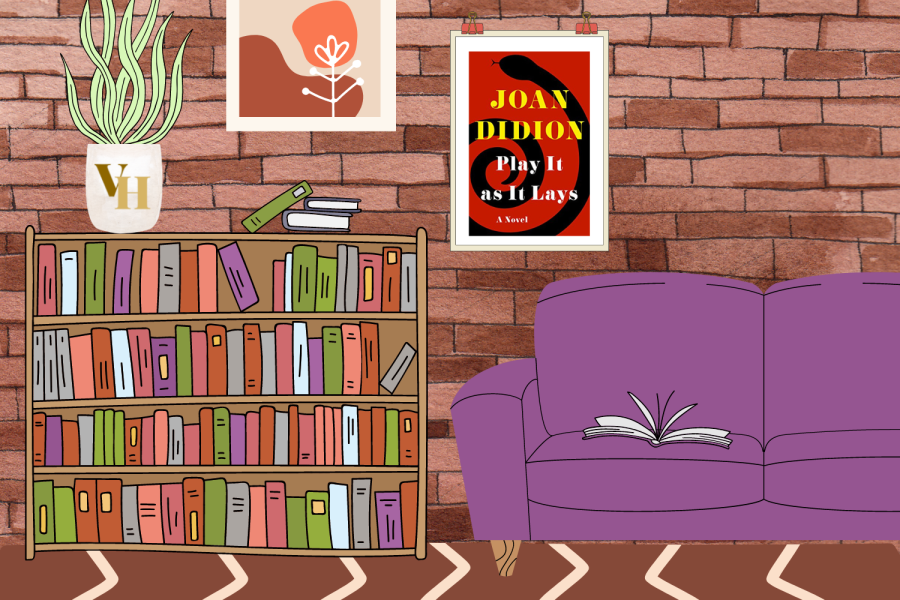Editor’s note: This review contains mention of fictional self-harm and suicide.
“Play It as It Lays” is an existential narrative of the 20th-century United States. The book dissects the crisis of American life by examining the pursuit of superficial success that lacks real values and its ugly consequences. Joan Didion masterfully cuts through the silent generation’s delusion with a serrated blade. “I was raised to believe that what came in on the next roll would always be better than what went out on the last. I no longer believe that, but I am telling you how it was.” With this defeatist line, the book’s narrator, Maria Wyeth, opens her story in a psychiatric facility in Los Angeles. Born and raised by a broke business owner in an inconsequential town in central Nevada, Maria eventually leaves the desert behind—only to find herself falling into the deceiving swamp of late 1960s Hollywood. Her time in the industry never shapes her into an accomplished actress. Stranded in a space where her past and future have both been blurred out of her view, Maria eventually finds herself in a fateful encounter with a metaphorical rattlesnake, whose warning sounds she has once ignored.
At first, Maria’s career seems to be poised for success. In New York City, her good looks and cinematic talents pave the way for minor achievements in the field. This momentum breaks off after her parents’ deaths. Living through this sudden loss, Maria slowly drifts away from the industry. Meanwhile, her job still leads her to the most significant enabler in her life: her husband, Carter Lang. They move to Hollywood, and Maria resumes her career by starring in two of Carter’s works. The couple later separates because of infidelities and ineffective, irrational communication. Nevertheless, the two remain emotionally tangled as loneliness is more unbearable than each other. Later finding herself pregnant with her former lover Les Goodwin’s child, Maria calls Carter out of a desperate need for help. The response she gets, however, is far from supportive: it is coercion into abortion. Disillusioned about a purposeless life and the loss of her child, Maria spends her days roaming California’s interstates. As she traverses the landscape with an increasingly arid soul, Maria spirals into a depressed headspace. The Hollywood dreamland sheds its camouflage and reveals the wasteland hidden underneath. Maria’s career pursuit disintegrates, giving away to an unorganized passivity that slowly spills over her entire life. She doesn’t snap out of this emotional inertia until her numbness allows one of her closest friends’ suicide to happen. Staring at empty alcohol bottles, unconsumed pills and her friend’s dead body, Maria collapses into her final breakdown.
The concepts of “being” and “nothingness” are a contrast that Didion extensively explores in “Play It as It Lays.” Maria’s disillusionment with the reality of the entertainment industry begins early in her career. In the book’s first half, the disinterest in her job signals the first crack of her dream. Moving from set to set, Maria shows little passion for the content she is producing. This apparent lack of enthusiasm on an artist’s side mirrors the shallowness of entertainment as a whole. Unable to even appeal to its cast, the film industry’s mass production of cinematic art fails to truly speak to people. Through Maria’s reaction to her work, we see firsthand how entertainment’s banality and commercial nature have removed the deep meaning of art, reducing it to near-nothingness despite its presence being in people’s leisure. This societal reality unfolds in front of our eyes while it simultaneously corrupts and derails Maria’s life.
Maria’s story is told in first-person retrospect. With deliberately flat yet truthful language, Maria relays intense introspections about her past life. She assesses moments of vulnerability and the impacts of emotional strain with a largely uninterested tone. This thoughtfully crafted ennui reflects the aftershock of trauma, accurately depicting Maria’s exhaustion and emotional stupor. Maria’s current state of mind directly contrasts with the perceived image of a Hollywood actress. Deprived of vibrance, energy and optimism, Maria embodies a broken dream that has nothing but a dull grayness left. Through Maria’s destruction, Didion reveals to her readers the rubbles behind celebrated successes: how a deceived limelight-seeker might try to emerge from behind a stage curtain and find their skulls crushing into a concrete wall instead. Didion critiques the conventional, materialistic success by exhibiting its power to destroy. In the book, the Hollywood dream is willed into existence by an ill society. It becomes the green light for a crowd of directionless people, luring them in and spitting out their bones. They emerge from the dream factory hollow and devastated, no longer fitting into the neon landscape. As Didion describes, Hollywood repelled individual troubles because “failures, illness, fear, they were seen as infectious, contagious blights on glossy plants.” Maria’s life in the glossy hills of Hollywood is beyond a singular incident of misfortune. Instead, it holds a common tragedy of her time: how people ignorantly went after a societal model of success only to accomplish nothing and find themselves blistered, wasted and ruined. Just like art during that time, these people were violently deprived and squashed to nothingness. Didion’s spare linguistic execution, through the perspective of a victim of the entertainment industry, frankly presents the messy aftermath and emotional turmoil imposed upon Maria by the pursuit of a hollow dream. In this way, Didion criticizes the lethargic and irresponsible American culture on the cusp of the 1970s.
Besides a toxic culture, personal loss is the other factor that ultimately causes Maria’s downfall. She keeps losing people dear to her: her parents, her husband, her child and finally, her only real friend in Hollywood. These peoples’ disappearances parallel the worsening of her mental state, separating her life in the book into five stages of grief. The loss of her parents starts the denial stage. Carter’s disloyalty triggers anger. Her resolution to self-destructive behavior to counter numbness represents bargaining. When she loses her child and collapses near her friend’s body, she is deep in the fourth stage: depression. Arguably, the book never explicitly grants Maria a stage of acceptance. She remains traumatized and disappointed as she writes this bitter and bruising account of her life. She is unwilling to pick up the pieces of her life but cynically narrates through her pain. However, from another perspective, the choice to talk about her story can be seen as a sign of acceptance. Didion leaves the motive behind Maria’s narration up to the readers. Is Maria in the recovery process, or is she deemed to stay in an irreversible and fragmented life-long tragedy? As readers, we get to decide. Therefore, this book presents a profound question for readers to answer. Didion thus incorporates her readers’ feelings and understanding into Maria’s story. We read Maria’s life as spectators and are welcome to derive meaning from it ourselves. In light of Maria’s tragedy, readers gain a highly personal understanding of societal superficiality, interpersonal relationships and their individual pursuits. Revisiting Maria’s story, as well as her fundamental elusiveness and uncertainty, almost always invokes more thoughts. She is uniquely complex, with many flaws and countless heartbreaks in a book that continues to startle readers with its intense prose and message.
When Maria ponders her early life in the mental hospital, she attributes her conclusion about life to her father: “My father advised me that life itself was a crap game: it was one of the two lessons I learned as a child. The other was that overturning a rock was to reveal a rattlesnake.” Having turned the rock herself and lived a subjectively “crap life,” Maria is nonetheless a survivor of this brutal game. In Californian sunshine and palm tree shades, she “[knows] what ‘nothing’ means, and [keeps] on playing.”













